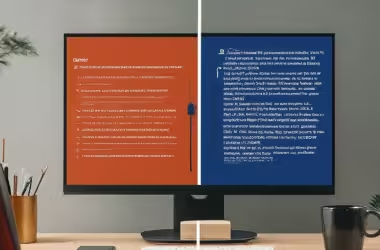Code refactoring is an essential practice in the world of software development. It involves making changes to code without altering its external behavior, ultimately improving code quality and reducing technical debt. But what are the best practices for effective refactoring? How can you ensure clean code and optimize your software engineering process? Let’s dive into the world of code refactoring and discover how it can lead to continuous improvement in your development workflow.
Key Takeaways:
- Code refactoring is the process of improving code without changing its external behavior.
- Refactoring helps maintain and improve code quality, reducing technical debt and complexity.
- It is important for preventing bugs, improving team productivity, and facilitating future changes.
- Understanding the codebase, identifying areas for improvement, and making incremental changes are key steps in the refactoring process.
- Refactoring should be an ongoing process to ensure continuous improvement and optimize software engineering practices.
Importance of Refactoring
Refactoring plays a crucial role in maintaining high code quality and reducing technical debt in software development. It encompasses the process of improving existing code without modifying its external behavior. By prioritizing refactoring, developers can enhance various aspects of their codebase to ensure long-term success.
One of the key benefits of refactoring is its contribution to code quality. By removing unnecessary code and improving algorithms, refactoring enhances software performance and efficiency. This results in a more streamlined and optimized codebase, enabling faster execution and improved user experience.
Furthermore, refactoring acts as a preventive measure against bugs. By continuously refining and optimizing the code, developers can proactively identify and eliminate potential issues before they manifest. This reduces the likelihood of unexpected errors and enhances the overall reliability of the software.
Refactoring also has a positive impact on team productivity. A clean and well-maintained codebase makes it easier for developers to understand and modify the code. This leads to faster development and debugging processes, enabling teams to deliver high-quality software more efficiently.
Additionally, refactoring facilitates future changes and updates. By regularly improving the codebase, developers ensure its adaptability to new requirements and technologies. Refactored code is more flexible and easier to modify, making it simpler to implement new features and functionalities in the future.
In summary, the importance of refactoring lies in its ability to maintain code quality, reduce technical debt, enhance software performance, prevent bugs, improve team productivity, and enable future changes. By making refactoring a fundamental part of the software development process, organizations can ensure a robust and adaptable codebase that supports long-term success.
Benefits of Refactoring
Refactoring provides numerous benefits for organizations, contributing to the overall success of their software development projects. By investing time and effort into refactoring, companies can reap the rewards of enhanced code functionality, improved maintenance processes, time and energy savings, efficient bug identification and fixing, and valuable developer education.
Code Functionality and Maintenance
Refactoring plays a vital role in ensuring the continuous functionality of code. As software evolves and requirements change, refactoring allows developers to optimize and improve the existing codebase without altering its external behavior. This results in a stable and reliable code foundation that can be easily maintained and expanded upon in the future.
Reduced Technical Debt
Technical debt refers to the long-term consequences of choosing suboptimal solutions during the development process. By consistently refactoring code, developers can actively address technical debt and reduce its accumulation. This proactive approach eliminates the need for extensive rework in the future and improves the overall quality of the software.
Time and Energy Savings
Refactoring helps developers save time and energy in the long run. By continuously improving code quality and readability, refactoring minimizes the effort required for troubleshooting and debugging. Additionally, refactored code is easier to understand and maintain, enabling developers to work more efficiently and effectively.
Bug Identification and Fixing
Through refactoring, developers gain a deeper understanding of the codebase, making it easier to identify and fix bugs. The process of refactoring often involves writing extensive tests and verifying the code behavior at each iteration. This rigorous testing approach helps catch and address bugs early, leading to a more stable and reliable software product.
Developer Education
Refactoring serves as an educational tool for developers, fostering continuous learning and knowledge sharing within the organization. By actively refactoring code, developers gain hands-on experience with different coding patterns, algorithms, and design principles. This promotes professional growth and creates a valuable resource base for future team members.
Summary
Refactoring offers a multitude of benefits that impact multiple aspects of software development. From improving code functionality and maintenance to reducing technical debt and saving time and energy, the advantages of refactoring are undeniable. Furthermore, refactoring fosters bug identification and fixing and contributes to developer education, creating a strong foundation for continuous improvement in software development practices.
When to Refactor Code
Refactoring code is a crucial practice that should be incorporated into regular maintenance activities. By proactively addressing code quality and technical debt through refactoring, developers can ensure the long-term stability and effectiveness of their software systems. Here are some key scenarios in which refactoring should be considered:
Regular Maintenance:
Regularly scheduled maintenance provides an ideal opportunity to refactor code. As part of routine maintenance activities, developers can review the codebase and identify areas for improvement. By dedicating time specifically for refactoring, teams can proactively address any existing code issues and enhance the overall quality and maintainability of the system.
Adding New Features:
Before implementing new features or functionalities, it is advisable to refactor the existing codebase. This helps prepare the development environment and prevents additional technical debt from accumulating. Refactoring prior to adding new features streamlines the codebase, making it more adaptable and easier to maintain in the long run.
Code and Peer Reviews:
Code and peer reviews provide valuable opportunities to identify areas that can benefit from refactoring. During these review sessions, team members can analyze the codebase, share insights, and suggest improvements. By actively seeking feedback and engaging in constructive discussions, developers can identify code sections that require refactoring, leading to enhanced code quality and improved overall performance.
Refactoring code during regular maintenance, before adding new features, and via code and peer reviews ensures that teams prioritize code quality, maintainability, and continuous improvement. By incorporating refactoring as an ongoing practice, developers can build and maintain software systems that are adaptable, efficient, and robust.
| When to Refactor Code | Description |
|---|---|
| During Regular Maintenance | Refactor code as part of routine maintenance activities to address existing issues and enhance overall quality. |
| Before Adding New Features | Refactor code to prepare the development environment and prevent additional technical debt accumulation. |
| Code and Peer Reviews | Identify areas for refactoring during code and peer reviews to improve code quality and performance. |
Code Refactoring Techniques
Improving code quality is an essential aspect of software development. To achieve this, developers can utilize various code refactoring techniques that optimize code structure, enhance readability, and reduce duplication. Let’s explore some of the most effective techniques:
1. Red-Green Refactor Technique
The red-green refactor technique is a powerful approach rooted in test-driven development. With this technique, developers write tests before writing the actual code. By following the red-green-refactor workflow, developers ensure the functionality of the code through failing (red) and passing (green) tests. Once the code passes the tests, they proceed to refactor it (refactor). This technique guarantees that code remains functional while continuously improving its design and efficiency 
2. Refactoring by Abstraction
Refactoring by abstraction is a technique employed to minimize duplication within large sets of code. It involves categorizing similar pieces of code based on shared attributes and then either grouping or moving them to improve code organization. This technique helps streamline the codebase, making it more maintainable and less prone to bugs.
3. Composing Method
The composing method technique focuses on enhancing code readability and reducing complexity. Developers achieve this by dividing methods into smaller blocks, improving code organization, and making it easier to understand. The extraction method breaks down a method into smaller, more manageable sections, while the inline method simplifies code logic and eliminates unnecessary method calls.
4. Simplifying Method
Simplifying method is a technique that aims to streamline the code logic and method calls. As code complexity can hinder maintainability and readability, simplifying method calls by removing unnecessary steps or simplifying the control flow can significantly improve code quality.
By applying these code refactoring techniques, developers can optimize code structure, eliminate redundancy, and improve code readability and maintainability. These techniques are invaluable tools in the quest for clean, efficient code.
Best Practices for Code Refactoring
When it comes to code refactoring, following best practices is key to ensuring successful implementation. These practices encompass various aspects, from code analysis and collaboration to testing and utilizing refactoring tools. Let’s explore these best practices in detail:
Analyze the Code and Understand its History
Before diving into the refactoring process, it is crucial to analyze the codebase and understand its history. This analysis helps identify areas that require improvement and provides valuable insights into the code’s structure and complexity. Understanding the code’s evolution is essential for making informed decisions during the refactoring process.
Justify Decisions to Management
While refactoring is essential for code quality and maintainability, justifying the need to refactor to management is equally important. Communicating the benefits, such as improved scalability, reduced technical debt, and enhanced productivity, can help secure support and resources for the refactoring efforts. The ability to justify decisions to management ensures a smoother implementation process.
Emphasize Team Collaboration
Refactoring should not be an isolated endeavor but a collaborative effort involving the entire development team. By encouraging team collaboration, everyone can contribute their expertise and insights, leading to more effective refactoring decisions. Collaborating with colleagues fosters knowledge sharing, enhances problem-solving, and results in a better overall codebase.
Test at Every Stage
Testing plays a vital role in the refactoring process. It is essential to have a comprehensive suite of tests that cover different scenarios and edge cases. Testing at every stage of the refactoring process ensures that the code remains functional and minimizes the risk of introducing new bugs. By maintaining a rigorous testing practice, developers can have confidence in the stability and reliability of the refactored code.
Utilize Refactoring Tools
Refactoring can be made more efficient with the help of specialized tools. These tools automate various aspects of the refactoring process, such as identifying code smells, suggesting improvements, and performing code transformations. Utilizing refactoring tools saves time and effort while promoting consistent and standardized refactoring practices.
By following these best practices for code refactoring—analyzing the code, justifying decisions, collaborating with the team, testing at every stage, and utilizing refactoring tools—developers can ensure a successful and impactful refactoring process. Implementing these practices will lead to cleaner, maintainable code that paves the way for future growth and enhancements.
What is Refactoring?
Refactoring is a crucial practice in software development that involves modifying the behavior or internal structure of code without changing its external structure. The primary objective of refactoring is to improve code readability and maintainability, while also mitigating the accumulation of technical debt.
While it is common to focus on code quality during the initial development phase, refactoring acknowledges that improvements can be made even after code is deployed. By continuously refining the codebase, developers can enhance its overall quality and ensure a more efficient and sustainable software system.
Benefits of Refactoring
- Improved code readability: Refactoring techniques such as removing dead code, standardizing code formatting, and clarifying variable names contribute to enhanced code legibility, making it easier to understand and maintain.
- Enhanced code maintainability: Through refactoring, code complexity can be reduced, making it more manageable and adaptable to future changes. This leads to a more maintainable codebase, facilitating easier updates and bug fixes.
- Prevention of technical debt: Refactoring helps address technical debt by systematically eliminating inefficiencies, reducing the likelihood of future issues and the accumulation of further debt.

Code refactoring serves as a strategic approach to ensure the long-term success of software projects. It involves making incremental improvements to the codebase, optimizing its structure, and improving its overall quality. This practice not only benefits the developers working on the code but also contributes to the success and sustainability of the software system as a whole.
Red-Green Refactor Technique
In the world of test-driven development, the red-green refactor technique is a valuable tool for writing clean and optimized code. This technique follows a three-step process, allowing developers to ensure functionality, improve code quality, and promote efficiency through code cleanup.
- Writing Failing Tests (Red): The first step of the red-green refactor technique involves writing failing tests. These tests are designed to check the behavior and functionality of the code. By intentionally writing tests that fail, developers can gain a clear understanding of what needs to be implemented or improved in their code.
- Implementing Code (Green): Once the failing tests are in place, developers proceed to implement the necessary code to make the tests pass. This step involves carefully writing the code required to fulfill the test conditions and successfully pass the tests.
- Code Cleanup and Optimization (Refactor): After the code passes the tests, it’s time to shift the focus towards code cleanup and optimization. This step of the red-green refactor technique involves reviewing the code and making improvements to its design, structure, and overall cleanliness. By refactoring the code, developers can enhance its readability, maintainability, and performance.
This three-step process, consisting of writing failing tests (red), implementing code to make the tests pass (green), and performing code cleanup and optimization (refactor), ensures that the code not only meets the required functionality but also adheres to best practices and quality standards.
The red-green refactor technique is an iterative approach to software development, allowing developers to continuously enhance their code, catch and correct errors, and produce cleaner and more efficient solutions. By incorporating this technique into your development workflow, you can improve the overall quality of your codebase and streamline the development process.
To visualize the red-green refactor technique in action, here’s an example scenario:
Example Scenario:
| # | Test | Code Implementation | Code Refactoring |
|---|---|---|---|
| 1 | Write a failing test to verify that a function properly calculates the sum of two numbers. | Implement the function with a basic sum calculation. | Optimize the function by handling edge cases, improving variable naming, and removing unnecessary code. |
| 2 | Write a failing test to ensure that the function handles negative numbers correctly. | Update the function to handle negative numbers. | Refactor the function by extracting common operations into separate helper functions for better code organization. |
| 3 | Write a failing test to confirm that the function works with decimal numbers. | Modify the function to handle decimal numbers. | Clean up the function by removing redundant code and improving the algorithm for better performance. |
By following the red-green refactor technique, developers can iteratively refine their code, ensuring its functionality, readability, and maintainability. This technique complements test-driven development by emphasizing the importance of writing failing tests, implementing code incrementally, and continuously improving code quality through effective cleanup and optimization.
Refactoring by Abstraction Technique
When working with large sets of code, reducing duplication and improving code organization are crucial for maintaining a clean and manageable codebase. One effective technique to achieve this is refactoring by abstraction. This technique involves categorizing code based on shared attributes and making changes to eliminate duplicate code.
Refactoring by abstraction begins with identifying sections of code that share common functionality or logic. By categorizing these sections, developers can determine the appropriate level of abstraction needed to improve code organization. This categorization can be based on various factors such as functionality, purpose, or behavior.
Reducing duplication is a primary goal of refactoring by abstraction. By identifying shared attributes among code segments, developers can extract common functionality into separate modules or classes. This process eliminates the need for redundant code, leading to more efficient and maintainable code.
Once the code has been categorized, developers can apply specific refactoring techniques to achieve the desired improvements. Two commonly used techniques in the context of refactoring by abstraction are the pull-up method and the push-down method.
Pull-Up Method
The pull-up method involves moving code from multiple classes to a common superclass. This technique is beneficial when there is duplicate code that can be shared among related classes. By consolidating the duplicated code into a superclass, developers can eliminate duplication and improve code organization. This also enhances code reusability and makes future modifications or additions more straightforward and less error-prone.
Push-Down Method
The push-down method, on the other hand, involves moving code from a superclass to one or more subclasses. This technique is useful when specific functionality is only required in specific subclasses, rather than at the superclass level. By pushing down the code to the appropriate subclasses, developers can improve code organization and ensure that each class possesses only the necessary functionality.
Overall, refactoring by abstraction is an essential technique for reducing duplication and improving code organization. By categorizing code and applying techniques like the pull-up method and the push-down method, developers can enhance code reusability, maintainability, and overall code quality.
| Refactoring by Abstraction Technique | Benefits |
|---|---|
| Reduces duplication within code | Improves code organization |
| Categorizes code based on shared attributes | Enhances code reusability |
| Utilizes the pull-up and push-down methods | Facilitates code maintenance and modifications |
Composing Method Technique
The composing method technique is a valuable approach to improve code readability and reduce complexity in software development. By dividing methods into smaller blocks, developers can enhance code organization and make it easier to understand and maintain.
One of the key methods used in the composing method technique is the extraction method. This process involves breaking down a larger method into smaller, more manageable blocks. By extracting specific functionalities into separate methods, developers can improve code modularity and make it easier to comprehend.
For example, let’s say we have a method that performs multiple calculations and validation checks. By applying the extraction method, we can split this method into smaller blocks, each responsible for a specific task. This not only improves code readability but also promotes code reuse and modularity.
Another important method used in the composing method technique is the inline method. This technique simplifies the code by eliminating unnecessary methods or calls. It involves directly placing the code logic inline, making the overall code structure more straightforward and concise.
By using the inline method, developers can eliminate the complexity associated with unnecessary method invocations and improve code performance. However, it’s crucial to strike a balance and ensure that the inline methods don’t become excessively lengthy or convoluted.
Overall, the composing method technique offers significant benefits in terms of code readability and complexity reduction. Whether through the extraction method or the inline method, developers can create more maintainable and efficient code structures.
Example:
| Before Composing Method Technique | After Composing Method Technique |
|---|---|
|
|
Conclusion
Code refactoring is an essential practice for improving software quality and reducing technical debt in software development. By following best practices and utilizing various refactoring techniques, developers can maintain a clean and maintainable codebase, leading to enhanced software performance and productivity.
Refactoring should be an ongoing process as it allows for continuous improvement in code quality and prevents the accumulation of technical debt over time. Regular refactoring helps identify and fix bugs, improves code readability, and facilitates future changes and additions to the codebase.
By prioritizing code refactoring, organizations can ensure that their software is of high quality, leading to better user experiences and increased customer satisfaction. Additionally, continuous refactoring promotes a culture of collaboration and learning within development teams, fostering growth and innovation.
In summary, code refactoring plays a crucial role in software development by enhancing software quality, reducing technical debt, and enabling continuous improvement. By making it a regular practice and investing time and resources into refactoring efforts, developers can maintain a clean codebase that is easily maintainable and adaptable to future needs.






